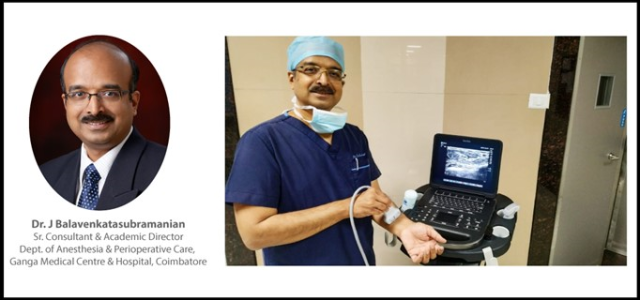
Dr J Balavenkatasubramanian is a Sr. consultant and academic director of department of Anesthesia & Perioperative Care at Ganga Medical Centre & Hospital, Coimbatore, India. He is the current President of the Asian Oceanic Society of Regional Anesthesia and Pain Medicine (AOSRA-PM) & the founder president of Academy of Regional Anesthesia (AORA) society of India. During our recent interaction with him, he shared his perspective on the role of point-of-care ultrasound in current clinical practice.
Ganga Hospital is a 650 bedded tertiary care referral center for trauma, orthopedics, reconstructive microvascular surgery, and hand surgery. In 2008, they procured their first compact ultrasound machine, the Sonosite M Turbo, and currently have 12 ultrasound machines in the department of Anesthesia & Perioperative Care including the Sonosite Edge II. They perform approximately 75 to 100 ultrasound guided nerve blocks daily with the help of these systems.
Multi-purpose usage of POCUS (Point-of-Care Ultrasound)
Dr Balavenkata shared that ‘on arrival block’ is introduced & religiously followed at Ganga hospital, where every trauma patient gets a peripheral block on arrival for instant pain relief. Anesthesiologists not only perform nerve blocks here but also function as a Perioperative care physician, and extensively utilize POCUS in their routine clinical practice.
In a polytrauma patient, eFAST, lung ultrasound, bedside echo, volume assessment etc. are all performed by the anesthesiologist itself. This is extremely useful in the resuscitation room as no time is lost in waiting to get a radiologist. Several major blunt trauma of abdomen and thorax patients survived because of the extensive use of these compact ultrasound machines in a timely manner. The postoperative paramedical staff of the hospital has been taught how to measure bladder volume which aid physicians in deciding about the timing of urinary bladder catheterization. Overall, the Ultrasound Guided Regional Anesthesia (USGRA) has become an integral component of their multimodal analgesia.
Propagating POCUS Education
Dr Balavenkata said “we started several educational initiatives to train and teach USGRA including a postdoctoral fellowship in nerve block and pain management, a one-year course affiliated with Dr MGR Medical University since 2012. We train two fellows every year. In collaboration with the World Federation of Society of Anesthesiologists (WFSA) we started an international regional anesthesia fellowship and have trained 20 Anesthesiologists under this six-month course from 16 countries. We started the six months regional anesthesia fellowship from 2010 and currently train 66 Anesthesiologists every year under this program. We are a postgraduate training center and have 12 postgraduates every year, all of them are trained systematically to use USGRA”.
Dr. Balavenkata conducts several live and hands-on workshops to train Anesthesiologists through the Academy of Regional Anesthesia (AORA) society of India and expressed his gratitude towards FUJIFILM Sonosite for always helping to conduct these academic workshops.
He further added:
“Ultrasound machines have aided us phenomenally in patient care in the perioperative period. This is a great tool which enables us to make quick decisions in a polytrauma patient, assisting with saving several lives, and providing instant pain relief to injured victims. The indications and usefulness of ultrasound is increasing every passing day. POCUS is an invaluable part of patient care, and every anesthesiologist should have access to a USG machine.”
POCUS role amidst COVID-19
Dr. Balavenkata stated that the COVID pandemic has opened yet another chapter in the use of POCUS in patients presenting to the emergency room with symptoms of COVID-19. Lung ultrasound exam in the ER is quite helpful in detecting lung lesions including subpleural lesions, consolidation, blood flow in the consolidated lung and pleural effusion. It also helped to evaluate the heart and the fluid status by measuring the IVC diameter. Overall, POCUS has proven to be a useful adjunct in patient care during this pandemic.


